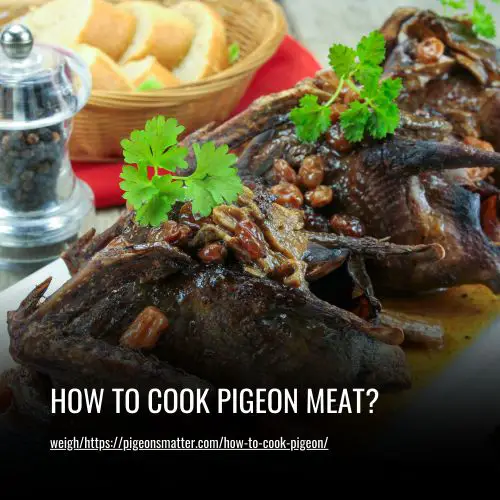Are you feeling adventurous in the kitchen? Do you want to try cooking unique and flavorful meat? Look no further than pigeon! This bird might not be the first choice for many home cooks, but it is a popular protein in many cultures around the world.
The following steps will help you in cooking Pigeon Meat:
- Necessary Ingredients for Cooking Pigeon Meat.
- Prepping the Pigeon Meat For Cooking.
- Marinating the Pigeon Meat.
- Pigeon Meat Cooking Methods
- Cooking Time and Temperature

1. Necessary Ingredients for Cooking Pigeon Meat:
If you want to cook pigeon meat, there are a few necessary ingredients that are required to make the dish palatable and delicious. Here are the necessary ingredients for cooking pigeon meat that you must have in your pantry:
- Pigeon Meat: This might go without saying, but you need to have pigeon meat to cook pigeons. Make sure that the meat is fresh and free of any added preservatives.
- Olive Oil: Olive oil is a popular cooking oil that is used in many dishes, including pigeon meat. It adds a subtle, fruity flavor to the dish while also making it moist and tender.
- Kosher Salt: Kosher salt is a vital ingredient that adds flavor and helps to season pigeon meat. Sea salt could also be used instead of kosher salt. However, do not go overboard with the amount used as it could ruin the dish.
- Black Pepper: Black pepper is another essential ingredient that adds flavor and depth to pigeon meat. It provides a spicy kick that enhances the overall taste of the dish.
- White Rice: White rice is a great option for serving with your cooked pigeon meat. It is a staple food that can be found in many kitchens and is a great accompaniment for many dishes.
Optional Ingredients for Enhancing the Flavor of the Dish
While the necessary ingredients are enough to make a delicious and flavorful pigeon dish, there are a few optional ingredients that you can add to enhance the taste further. If you want to create a unique taste profile, consider adding the following ingredients:
- Rock Sugar: Rock sugar is a popular ingredient used in Chinese cuisine. It adds a subtle sweetness to the dish that can help to balance out any spiciness from the black pepper. You can add a small piece of rock sugar to the cooking liquid when slow-cooking pigeon meat to infuse the flavors.
- Cloves Garlic: Garlic adds a robust flavor and aroma to the dish. It is a versatile ingredient that goes well with almost any dish, including pigeon meat. Crush a few cloves of garlic and sauté them in olive oil before adding the pigeon meat for an added depth of flavor.
- Black Pepper: Use black pepper in moderation to add a spicy kick to the dish. As mentioned earlier, black pepper is an essential ingredient that adds depth and flavor to pigeon meat. A pinch of black pepper goes a long way, so use it sparingly.
2. Prepping the Pigeon Meat For Cooking:
Before you begin cooking your pigeon, it is essential to properly clean and prepare the bird. This process involves removing the feathers, gizzards, and other unwanted parts of the whole bird. If you prefer, you can also choose to de-bone and skin the pigeon for a different cooking experience. Here are the steps to follow to prep your pigeon before cooking:
- Start by plucking the feathers from the bird’s body. Make sure to do this carefully and ensure that no feathers are left behind.
- Next, remove the head and feet of the bird and set them aside.
- Using a sharp knife, carefully cut along the belly of the bird, opening it up so you can remove its internal organs. This includes the gizzards, liver, and any other unwanted parts.
- Rinse the bird with cold water to remove any excess blood or debris. If you prefer, you can soak the bird in cold water with a splash of vinegar to further clean and tenderize the meat.
If you choose to de-bone and skin the pigeon, carefully slice along the backbone of the bird and remove the bones. Then, place the bird skin-side down on a cutting board and use a sharp knife to cut between the skin and the meat, separating the skin from the flesh.
De-boning and Skinning the Bird, if Desired
Once you have prepared the whole pigeon, you may decide to debone and skin it for a neater presentation or because you prefer the texture without the bones. This step is optional, but it can improve the aesthetic of your dish and make it easier to eat.
To debone the pigeon, first, use a sharp knife to make a shallow incision along the center of the breastbone. Be careful not to cut through the bone, but just enough to expose it. Next, use the knife to carefully cut along the bone, freeing the meat from the bone as you go. Use your fingers or a spoon to push the meat away from the bone, making sure to remove all of the bones as you go.
Skinning the bird is another option that can be done simultaneously with deboning. To do this, use your knife to make a small incision at the base of the neck and near the tail, being careful not to pierce the meat. Gently use your fingers to loosen the skin, carefully working your way around the bird. Once the skin is loosened, use your knife to separate it from the meat.
Keep in mind that deboning and skinning the bird can be time-consuming and require precision. However, if executed properly, it can significantly improve the presentation of your dish. If you are short on time or not confident in your knife skills, it may be best to skip this step and cook the pigeon as is.
3. Marinating the Pigeon Meat:
Marinating pigeon meat before cooking can enhance its flavor and tenderness. A marinade is a mixture of liquids and seasonings in which the meat is soaked before cooking to infuse it with flavor and moisture.
In this section, we’ll explore how to create a marinade that will take your pigeon meat to the next level in terms of taste and texture. Follow these steps to create a delicious and aromatic marinade that will make your pigeon breast irresistible.
To create a marinade for pigeon meat, start by combining olive oil, fresh herbs, garlic cloves, kosher salt, black pepper, and a splash of lemon juice in a bowl. Stir the ingredients together until they are well combined.
Place your cleaned and trimmed pigeon breasts in a separate dish or ziplock bag and pour the marinade over the meat, ensuring that each piece is coated in the mixture. Cover the dish or seal the bag and refrigerate for at least an hour or up to overnight for optimal flavor and tenderness.
When you’re ready to cook the marinated pigeon meat, remove it from the marinade, allowing any excess to drip off, and discard the remaining marinade. Grill, roast, or braise the meat according to your preferred cooking method, taking care not to overcook it.
The result will be a succulent, tender, and tasty pigeon breast with a depth of flavor that can only be achieved with a good marinade.
Creating a Marinade for Optimal Flavor
When it comes to cooking pigeon meat, marinating it beforehand can take the taste and texture to the next level. A marinade is a mixture of liquids and seasonings that adds moisture and flavor to the meat. Here’s how to create a marinade that will infuse your pigeon breast with optimal flavor and tenderness.
To create a Jamaican-style marinade, start by whisking together olive oil, kosher salt, black pepper, and minced garlic. Next, add in a tablespoon of jerk seasoning, which can be found at most grocery stores, and a small diced scotch bonnet pepper to give the marinade some heat. Finally, add a tablespoon of fresh thyme leaves for a fragrant touch to the mixture.
Now it’s time to prepare the pigeon breast before adding the marinade. Clean and trim the meat and make sure to pat it dry with a paper towel to remove any excess moisture. Place the pigeon breast in a separate dish or a ziplock bag, making sure that it is not crowded and has plenty of room to soak in the marinade.
Pour the marinade over the pigeon breast, making sure to coat it evenly on all sides. If using a ziplock bag, seal it tightly and give it a gentle massage to distribute the marinade. Place the dish or bag in the refrigerator and allow the meat to marinate for at least one hour or up to overnight for maximum flavor infusion.
3. Pigeon Meat Cooking Methods:
Cooking pigeons can be done in many ways, each method offering unique results. Two popular cooking methods for pigeons are roasting and braising. Roasting can be done in an oven or on a grill and involves dry heat cooking for a short period, producing a crispy exterior and succulent interior.
Braising, on the other hand, involves slow-cooking the pigeon in a flavorful liquid, creating a tender and juicy dish. Both methods offer a range of possibilities in terms of flavor and texture and can be customized for personal taste preferences.
Roasting in an Oven or on a Grill
Roasting pigeon is a great way to cook meat to perfection, as it uses dry heat to create a crispy exterior and moist interior. If you have access to a grill or an oven, then roasting pigeon is a great way to enjoy a delicious and savory meal.
To get started, first, set your oven or grill to medium heat. Then, take your pigeon meat and season it with herbs, kosher salt, and black pepper to your liking. If you prefer a spicier dish, then you can add additional seasonings such as cayenne pepper, garlic, or paprika.
Once seasoned, place the pigeon meat on a roasting pan or grill grate and cook for about 20-30 minutes, depending on the size of the meat. Make sure to turn the meat occasionally to ensure even cooking on all sides.
Braising in a Pot or Slow Cooker
Braising is another fantastic cooking method for pigeon meat. This technique involves cooking the meat slowly in a pot or slow cooker with a flavorful liquid, resulting in tender and succulent meat.
To braise pigeon meat, start by seasoning it with herbs, kosher salt, and black pepper to your liking. Next, heat a pot or slow cooker to medium heat and add a tablespoon of cooking oil. Brown the pigeon meat on all sides, about 2-3 minutes per side.
Once the meat is browned, remove it from the pot and set it aside. In the same pot or slow cooker, add aromatics such as onions, garlic, and bay leaves. Pour in enough liquid to cover the meat, such as broth, wine, or a combination of both. Add more seasoning to the liquid if desired, such as thyme, rosemary, or paprika.
Return the meat to the pot and cover it with a lid. Reduce the heat to low and allow the meat to braise for 2-3 hours in a pot or 4-6 hours in a slow cooker. The meat should be tender and fall off the bone by the end of the cooking process.
Once the pigeon meat is fully cooked, remove it from the pot and let it rest for a few minutes before serving. You can strain the remaining liquid to use as a flavorful sauce or gravy for the meat.
Braising is a wonderful way to cook pigeon meat as it infuses the meat with rich flavors while resulting in a juicy and tender dish. Try this method the next time you have some pigeon meat on hand and impress your guests with its irresistible flavor and texture.
4. Cooking Time and Temperature:
When it comes to cooking pigeons, ensuring the right cooking time and temperature can make all the difference in the final product. Different cooking methods require different timings and temperatures to achieve the best results. Here are some tips to help you cook your pigeon perfectly depending on your chosen method.
Roasting is a popular cooking method for pigeons as it infuses the meat with rich flavors. To roast a pigeon, preheat your oven to 400°F (200°C) and place the cleaned and prepared pigeon in a roasting pan. Roast the pigeon for 20-25 minutes, or until the internal temperature of the meat reaches 160°F (71°C). Once cooked, remove the pigeon from the oven and let it rest for a few minutes before slicing.
Pan-frying your pigeon is another great option that can produce a delicious and juicy result. To pan-fry a pigeon, heat a tablespoon of cooking oil in a frying pan over medium heat. Once the oil is hot, add your cleaned and prepared pigeon breast to the pan. Cook the pigeon on each side for 3-4 minutes until the internal temperature reaches 160°F (71°C). Always make sure to use a meat thermometer to accurately measure the internal temperature of your pigeon meat.
If you’re looking for a low-fat option, consider slow-cooking your pigeon. The low heat over an extended period ensures that the meat remains moist and flavorful. Simply place your cleaned and prepared pigeon in a slow cooker with some broth or cooking liquid, and cook on low heat for 4-6 hours until the meat is tender and fully cooked.
Why You Will Love This Recipe
You will love this recipe for several reasons. Firstly, it is low in fat, making it a healthier option for you and your family. Secondly, the meat used in the recipe is sustainable, which means that it is environmentally friendly and ethically sourced.
The portions are perfectly sized for serving, which makes meal prep a breeze. You won’t have to worry about last-minute carving as the recipe is designed to be easy to prepare. It only takes less than 15 minutes to cook!
Finally, this recipe is perfect for entertaining. It is simple to make, yet elegant enough to impress your guests. If you’re looking for a delicious, healthy, and easy-to-prepare recipe for your next meal, then this is the one for you.
Benefits of Eating Pigeon Meat
Pigeon meat is a great source of high nutritional value, being a good group of protein, and low in fat and cholesterol. Analysis of pigeon meat has shown that it contains about 24% protein, which is higher than that of other animal meats. In addition, the fat content in pigeon meat is only about 0.3%, which is much lower than other meats.
Moreover, pigeon meat contains many essential amino acids needed by the body, which makes it a perfect ingredient for a nourishing diet. The meat is also rich in vitamins A, B1, B2, E, and trace and macro minerals that provide numerous health benefits to the body.
Eating pigeon meat has several health benefits. It helps the body to heal wounds quickly and speed up rehabilitation after illness. Meat also helps to nourish the brain, improve memory, and enhance thinking ability. In addition, it helps to nourish the face, keeping it radiant and youthful while boosting the body’s vitality.
FAQs
Roast pigeon is a type of dark meat that resembles duck in texture and appearance, despite being smaller in size. The flavor is notably rich and strong, differing greatly from chicken and more closely resembling a savory steak.
Pigeons don’t have much meat, mostly on the breast. It’s free range, so there’s little fat. The best way to cook the whole bird is to roast it quickly, retaining moisture by cooking on the bone and with a bacon blanket for basting. Pigeon breasts can be pan-fried and served rare, like in this recipe for pigeon breast with blackberry sauce.
In various restaurants globally, the cooked pigeon is commonly labeled as squab, but in the UK it is simply referred to as pigeon on menus. Technically, a squab is a bird that is slaughtered at approximately four weeks old, though I am not knowledgeable about this procedure. Pigeons consumed in the UK are of the wild wood pigeon breed, hunted in rural areas, and not the urban-dwelling pigeons.
Pigeon meat is safe for consumption when properly handled and cooked thoroughly. It’s essential to ensure that the meat is sourced from a reputable and hygienic supplier to reduce any potential health risks.
Pigeon meat can be prepared in various ways, including roasting, grilling, braising, or pan-searing. Marinating the meat with herbs and spices before cooking can enhance its flavor.
Pigeon meat should be cooked to an internal temperature of at least 165°F (74°C) to ensure it’s safe to eat. Using a meat thermometer is recommended to accurately gauge the temperature.
Pigeon meat is often described as having a rich, gamey flavor similar to duck or squab. It’s known for its tender texture and can take on the flavors of the seasonings used during cooking.
Pigeon meat is lean, so it’s crucial not to overcook it to avoid making it tough. It’s recommended to use cooking methods that retain moisture, such as basting or cooking at lower temperatures for a shorter time.
Yes, pigeon meat can be used as a substitute for other poultry meats like chicken or duck in various recipes. Its distinctive flavor can add a unique twist to dishes like stews, pies, or even grilled preparations.
Conclusion:
Mastering the art of cooking pigeons is not only a culinary adventure but also a chance to expand your palate and explore a unique culinary experience. So let your taste buds soar high and embrace the flavors of this delectable bird.
Remember, with proper preparation and a dash of creativity, cooking pigeons can elevate your culinary skills and leave your guests in awe. So spread your culinary wings, and start cooking! Bon appétit!


